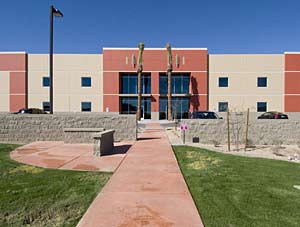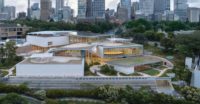In the not-too-distant future, there could be two U.S. standards for green buildings. The American Society of Heating, Refrigerating and Air-Conditioning Engineers (ASHRAE), in conjunction with two other industry organizations, is developing the Standard for the Design of High-Performance Green Buildings Except Low-Rise Residential Buildings. Meanwhile, the three-year-old, nonprofit Green Building Initiative (GBI) is also working toward establishing its Green Globes rating system for commercial buildings as an official standard. Both organizations are following the protocols of the American National Standards Institute (ANSI) and expect to release fully completed and approved documents by the end of 2008.

The ASHRAE initiative, also known as Standard 189, is being developed with the U.S. Green Building Council (USGBC) and the Illuminating Engineering Society of North America (IESNA), and could ultimately become a prerequisite under the LEED rating system. The organizations recently released a second draft of the standard for public comment. Until April 7, 2008, the document is available at www.ashrae.org/publicreviews.
With 189, ASHRAE and its partners hope to provide a baseline definition of green building in code-enforceable language. The standard is conceived as an appendix to the International Building Code that jurisdictions could adopt “and code officials would understand how to enforce,” explains Kent Peterson, ASHRAE president and a principal of P2S Engineering, based in Long Beach, California. Although many cities and states have incorporated LEED, and to a lesser extent Green Globes, into green-building legislation and executive orders, the rating systems were not originally devised for that purpose. “Jurisdictions have adopted the rating systems, but they are struggling to interpret them,” says Peterson.
In contrast to the code- ready format of 189, the GBI standard would not be written in “mandatory” language. It would establish guidelines for multiple building-performance levels designated by one to four “globes.” According to Vicki Warden, GBI’s vice president of commercial programs and product development, “the standard is not intended to elevate code, but to be an incentive for achieving higher levels of performance.” The group plans to release its first draft for public comment sometime this spring.
Standard 189 will address sites, water use, materials, and indoor air quality, among other issues. It is also part of a set of ASHRAE initiatives aimed at helping teams design more efficient buildings, with the ultimate goal of creating net-zero-energy buildings—those that consume no more energy than they generate on an annual basis. The ASHRAE net-zero initiatives were outlined at the organization’s winter meeting held in New York City in late January. These include a set of Advanced Energy Design Guides, a series of publications tailored to specific building types and providing guidance for achieving 30 percent energy reduction. A set of 50 percent energy reduction guides is due to be published later this year. Eventually, ASHRAE plans to offer a series focused on net-zero buildings.
One goal of standard 189 is to achieve a 30 percent reduction in energy cost over the 2007 version of building energy standard, ASHRAE/IESNA 90.1. Standard 189 will also contain a requirement that a minimum of 1 percent of peak energy come from renewable sources and is generated on site. With each revision of 189, the energy-efficiency and renewable requirements would become more stringent, “so that we are approaching net-zero energy by 2030,” Peterson says.






Post a comment to this article
Report Abusive Comment